Understanding and Managing People: Maslow's Hierarchy of Needs
VerifiedAdded on 2023/06/18
|8
|1947
|368
AI Summary
This article discusses Maslow's Hierarchy of Needs and how it can be applied to motivate employees in an organization. It outlines the five needs of individuals that start from very basic to self-fulfillment needs that motivate individuals to work for organizational objectives. The article also discusses the advantages and disadvantages of this theory.
Contribute Materials
Your contribution can guide someone’s learning journey. Share your
documents today.

Understanding and Managing
People
People
Secure Best Marks with AI Grader
Need help grading? Try our AI Grader for instant feedback on your assignments.
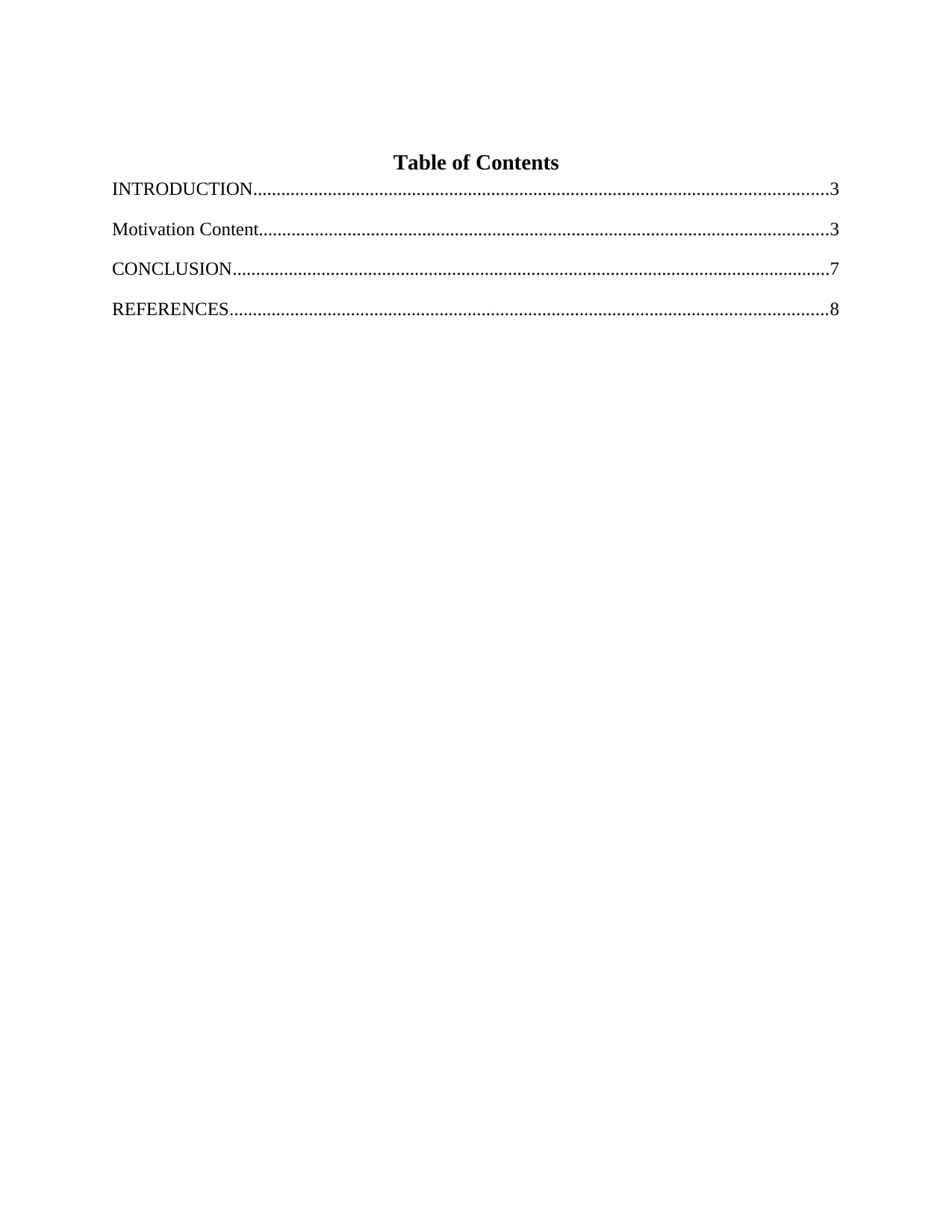
Table of Contents
INTRODUCTION...........................................................................................................................3
Motivation Content..........................................................................................................................3
CONCLUSION................................................................................................................................7
REFERENCES................................................................................................................................8
INTRODUCTION...........................................................................................................................3
Motivation Content..........................................................................................................................3
CONCLUSION................................................................................................................................7
REFERENCES................................................................................................................................8
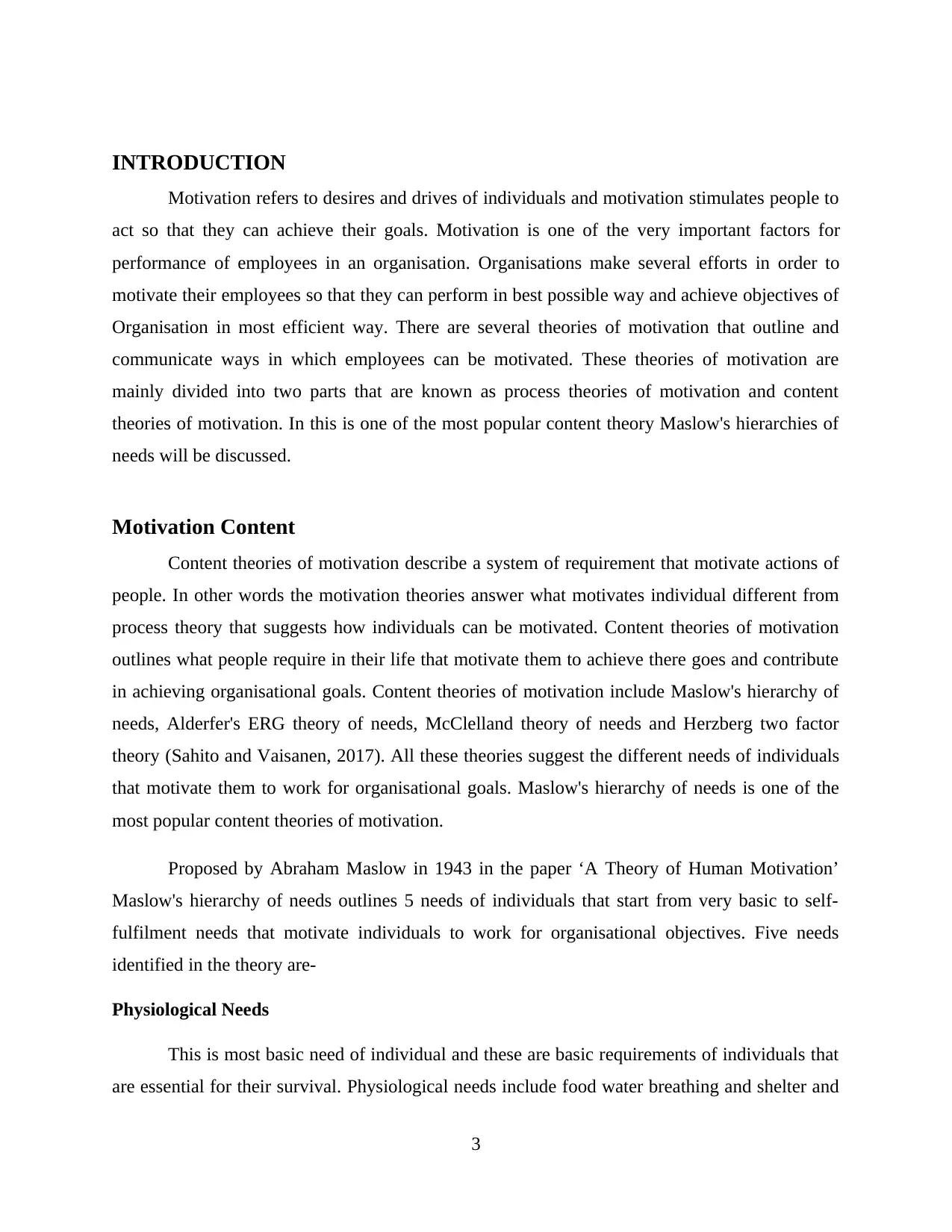
INTRODUCTION
Motivation refers to desires and drives of individuals and motivation stimulates people to
act so that they can achieve their goals. Motivation is one of the very important factors for
performance of employees in an organisation. Organisations make several efforts in order to
motivate their employees so that they can perform in best possible way and achieve objectives of
Organisation in most efficient way. There are several theories of motivation that outline and
communicate ways in which employees can be motivated. These theories of motivation are
mainly divided into two parts that are known as process theories of motivation and content
theories of motivation. In this is one of the most popular content theory Maslow's hierarchies of
needs will be discussed.
Motivation Content
Content theories of motivation describe a system of requirement that motivate actions of
people. In other words the motivation theories answer what motivates individual different from
process theory that suggests how individuals can be motivated. Content theories of motivation
outlines what people require in their life that motivate them to achieve there goes and contribute
in achieving organisational goals. Content theories of motivation include Maslow's hierarchy of
needs, Alderfer's ERG theory of needs, McClelland theory of needs and Herzberg two factor
theory (Sahito and Vaisanen, 2017). All these theories suggest the different needs of individuals
that motivate them to work for organisational goals. Maslow's hierarchy of needs is one of the
most popular content theories of motivation.
Proposed by Abraham Maslow in 1943 in the paper ‘A Theory of Human Motivation’
Maslow's hierarchy of needs outlines 5 needs of individuals that start from very basic to self-
fulfilment needs that motivate individuals to work for organisational objectives. Five needs
identified in the theory are-
Physiological Needs
This is most basic need of individual and these are basic requirements of individuals that
are essential for their survival. Physiological needs include food water breathing and shelter and
3
Motivation refers to desires and drives of individuals and motivation stimulates people to
act so that they can achieve their goals. Motivation is one of the very important factors for
performance of employees in an organisation. Organisations make several efforts in order to
motivate their employees so that they can perform in best possible way and achieve objectives of
Organisation in most efficient way. There are several theories of motivation that outline and
communicate ways in which employees can be motivated. These theories of motivation are
mainly divided into two parts that are known as process theories of motivation and content
theories of motivation. In this is one of the most popular content theory Maslow's hierarchies of
needs will be discussed.
Motivation Content
Content theories of motivation describe a system of requirement that motivate actions of
people. In other words the motivation theories answer what motivates individual different from
process theory that suggests how individuals can be motivated. Content theories of motivation
outlines what people require in their life that motivate them to achieve there goes and contribute
in achieving organisational goals. Content theories of motivation include Maslow's hierarchy of
needs, Alderfer's ERG theory of needs, McClelland theory of needs and Herzberg two factor
theory (Sahito and Vaisanen, 2017). All these theories suggest the different needs of individuals
that motivate them to work for organisational goals. Maslow's hierarchy of needs is one of the
most popular content theories of motivation.
Proposed by Abraham Maslow in 1943 in the paper ‘A Theory of Human Motivation’
Maslow's hierarchy of needs outlines 5 needs of individuals that start from very basic to self-
fulfilment needs that motivate individuals to work for organisational objectives. Five needs
identified in the theory are-
Physiological Needs
This is most basic need of individual and these are basic requirements of individuals that
are essential for their survival. Physiological needs include food water breathing and shelter and
3
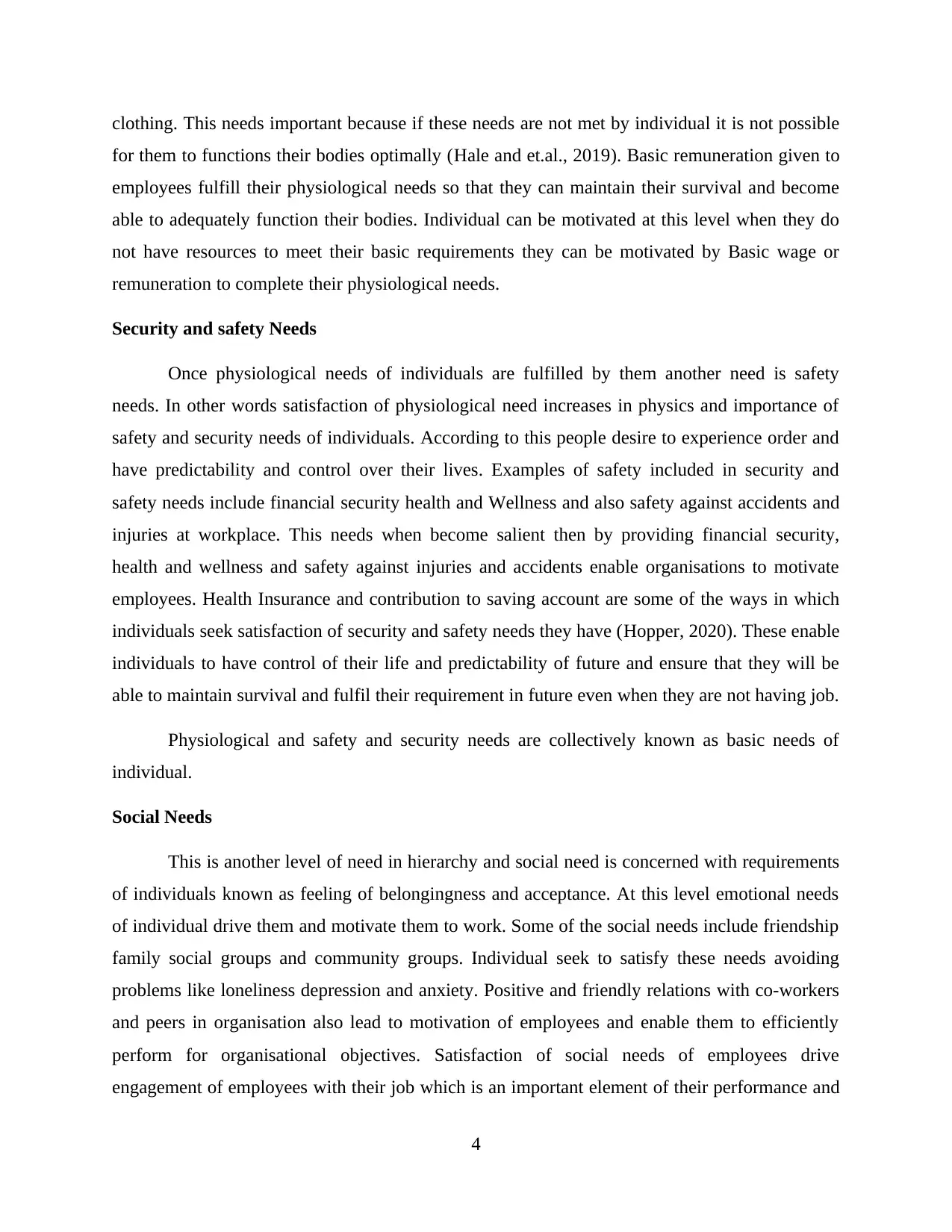
clothing. This needs important because if these needs are not met by individual it is not possible
for them to functions their bodies optimally (Hale and et.al., 2019). Basic remuneration given to
employees fulfill their physiological needs so that they can maintain their survival and become
able to adequately function their bodies. Individual can be motivated at this level when they do
not have resources to meet their basic requirements they can be motivated by Basic wage or
remuneration to complete their physiological needs.
Security and safety Needs
Once physiological needs of individuals are fulfilled by them another need is safety
needs. In other words satisfaction of physiological need increases in physics and importance of
safety and security needs of individuals. According to this people desire to experience order and
have predictability and control over their lives. Examples of safety included in security and
safety needs include financial security health and Wellness and also safety against accidents and
injuries at workplace. This needs when become salient then by providing financial security,
health and wellness and safety against injuries and accidents enable organisations to motivate
employees. Health Insurance and contribution to saving account are some of the ways in which
individuals seek satisfaction of security and safety needs they have (Hopper, 2020). These enable
individuals to have control of their life and predictability of future and ensure that they will be
able to maintain survival and fulfil their requirement in future even when they are not having job.
Physiological and safety and security needs are collectively known as basic needs of
individual.
Social Needs
This is another level of need in hierarchy and social need is concerned with requirements
of individuals known as feeling of belongingness and acceptance. At this level emotional needs
of individual drive them and motivate them to work. Some of the social needs include friendship
family social groups and community groups. Individual seek to satisfy these needs avoiding
problems like loneliness depression and anxiety. Positive and friendly relations with co-workers
and peers in organisation also lead to motivation of employees and enable them to efficiently
perform for organisational objectives. Satisfaction of social needs of employees drive
engagement of employees with their job which is an important element of their performance and
4
for them to functions their bodies optimally (Hale and et.al., 2019). Basic remuneration given to
employees fulfill their physiological needs so that they can maintain their survival and become
able to adequately function their bodies. Individual can be motivated at this level when they do
not have resources to meet their basic requirements they can be motivated by Basic wage or
remuneration to complete their physiological needs.
Security and safety Needs
Once physiological needs of individuals are fulfilled by them another need is safety
needs. In other words satisfaction of physiological need increases in physics and importance of
safety and security needs of individuals. According to this people desire to experience order and
have predictability and control over their lives. Examples of safety included in security and
safety needs include financial security health and Wellness and also safety against accidents and
injuries at workplace. This needs when become salient then by providing financial security,
health and wellness and safety against injuries and accidents enable organisations to motivate
employees. Health Insurance and contribution to saving account are some of the ways in which
individuals seek satisfaction of security and safety needs they have (Hopper, 2020). These enable
individuals to have control of their life and predictability of future and ensure that they will be
able to maintain survival and fulfil their requirement in future even when they are not having job.
Physiological and safety and security needs are collectively known as basic needs of
individual.
Social Needs
This is another level of need in hierarchy and social need is concerned with requirements
of individuals known as feeling of belongingness and acceptance. At this level emotional needs
of individual drive them and motivate them to work. Some of the social needs include friendship
family social groups and community groups. Individual seek to satisfy these needs avoiding
problems like loneliness depression and anxiety. Positive and friendly relations with co-workers
and peers in organisation also lead to motivation of employees and enable them to efficiently
perform for organisational objectives. Satisfaction of social needs of employees drive
engagement of employees with their job which is an important element of their performance and
4
Secure Best Marks with AI Grader
Need help grading? Try our AI Grader for instant feedback on your assignments.
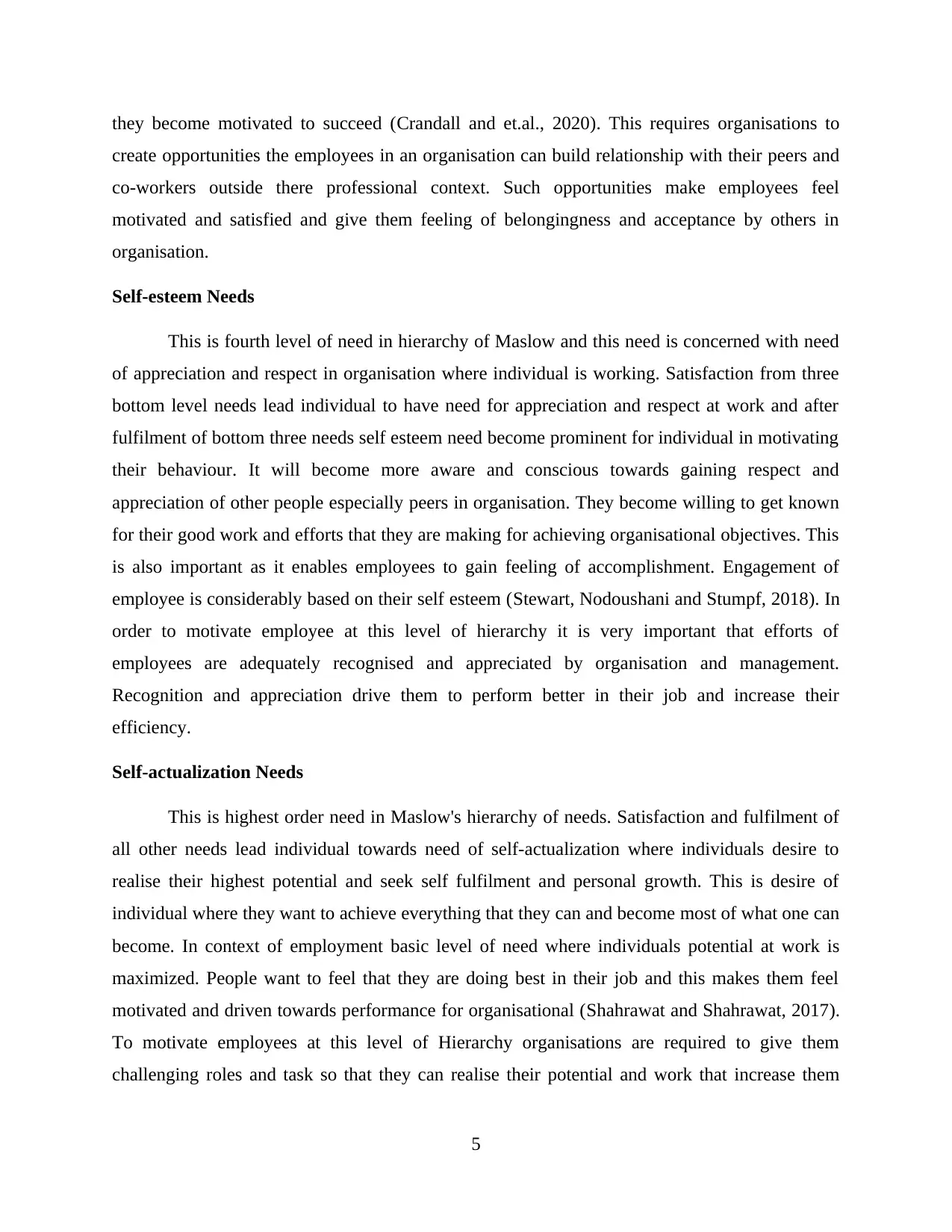
they become motivated to succeed (Crandall and et.al., 2020). This requires organisations to
create opportunities the employees in an organisation can build relationship with their peers and
co-workers outside there professional context. Such opportunities make employees feel
motivated and satisfied and give them feeling of belongingness and acceptance by others in
organisation.
Self-esteem Needs
This is fourth level of need in hierarchy of Maslow and this need is concerned with need
of appreciation and respect in organisation where individual is working. Satisfaction from three
bottom level needs lead individual to have need for appreciation and respect at work and after
fulfilment of bottom three needs self esteem need become prominent for individual in motivating
their behaviour. It will become more aware and conscious towards gaining respect and
appreciation of other people especially peers in organisation. They become willing to get known
for their good work and efforts that they are making for achieving organisational objectives. This
is also important as it enables employees to gain feeling of accomplishment. Engagement of
employee is considerably based on their self esteem (Stewart, Nodoushani and Stumpf, 2018). In
order to motivate employee at this level of hierarchy it is very important that efforts of
employees are adequately recognised and appreciated by organisation and management.
Recognition and appreciation drive them to perform better in their job and increase their
efficiency.
Self-actualization Needs
This is highest order need in Maslow's hierarchy of needs. Satisfaction and fulfilment of
all other needs lead individual towards need of self-actualization where individuals desire to
realise their highest potential and seek self fulfilment and personal growth. This is desire of
individual where they want to achieve everything that they can and become most of what one can
become. In context of employment basic level of need where individuals potential at work is
maximized. People want to feel that they are doing best in their job and this makes them feel
motivated and driven towards performance for organisational (Shahrawat and Shahrawat, 2017).
To motivate employees at this level of Hierarchy organisations are required to give them
challenging roles and task so that they can realise their potential and work that increase them
5
create opportunities the employees in an organisation can build relationship with their peers and
co-workers outside there professional context. Such opportunities make employees feel
motivated and satisfied and give them feeling of belongingness and acceptance by others in
organisation.
Self-esteem Needs
This is fourth level of need in hierarchy of Maslow and this need is concerned with need
of appreciation and respect in organisation where individual is working. Satisfaction from three
bottom level needs lead individual to have need for appreciation and respect at work and after
fulfilment of bottom three needs self esteem need become prominent for individual in motivating
their behaviour. It will become more aware and conscious towards gaining respect and
appreciation of other people especially peers in organisation. They become willing to get known
for their good work and efforts that they are making for achieving organisational objectives. This
is also important as it enables employees to gain feeling of accomplishment. Engagement of
employee is considerably based on their self esteem (Stewart, Nodoushani and Stumpf, 2018). In
order to motivate employee at this level of hierarchy it is very important that efforts of
employees are adequately recognised and appreciated by organisation and management.
Recognition and appreciation drive them to perform better in their job and increase their
efficiency.
Self-actualization Needs
This is highest order need in Maslow's hierarchy of needs. Satisfaction and fulfilment of
all other needs lead individual towards need of self-actualization where individuals desire to
realise their highest potential and seek self fulfilment and personal growth. This is desire of
individual where they want to achieve everything that they can and become most of what one can
become. In context of employment basic level of need where individuals potential at work is
maximized. People want to feel that they are doing best in their job and this makes them feel
motivated and driven towards performance for organisational (Shahrawat and Shahrawat, 2017).
To motivate employees at this level of Hierarchy organisations are required to give them
challenging roles and task so that they can realise their potential and work that increase them
5
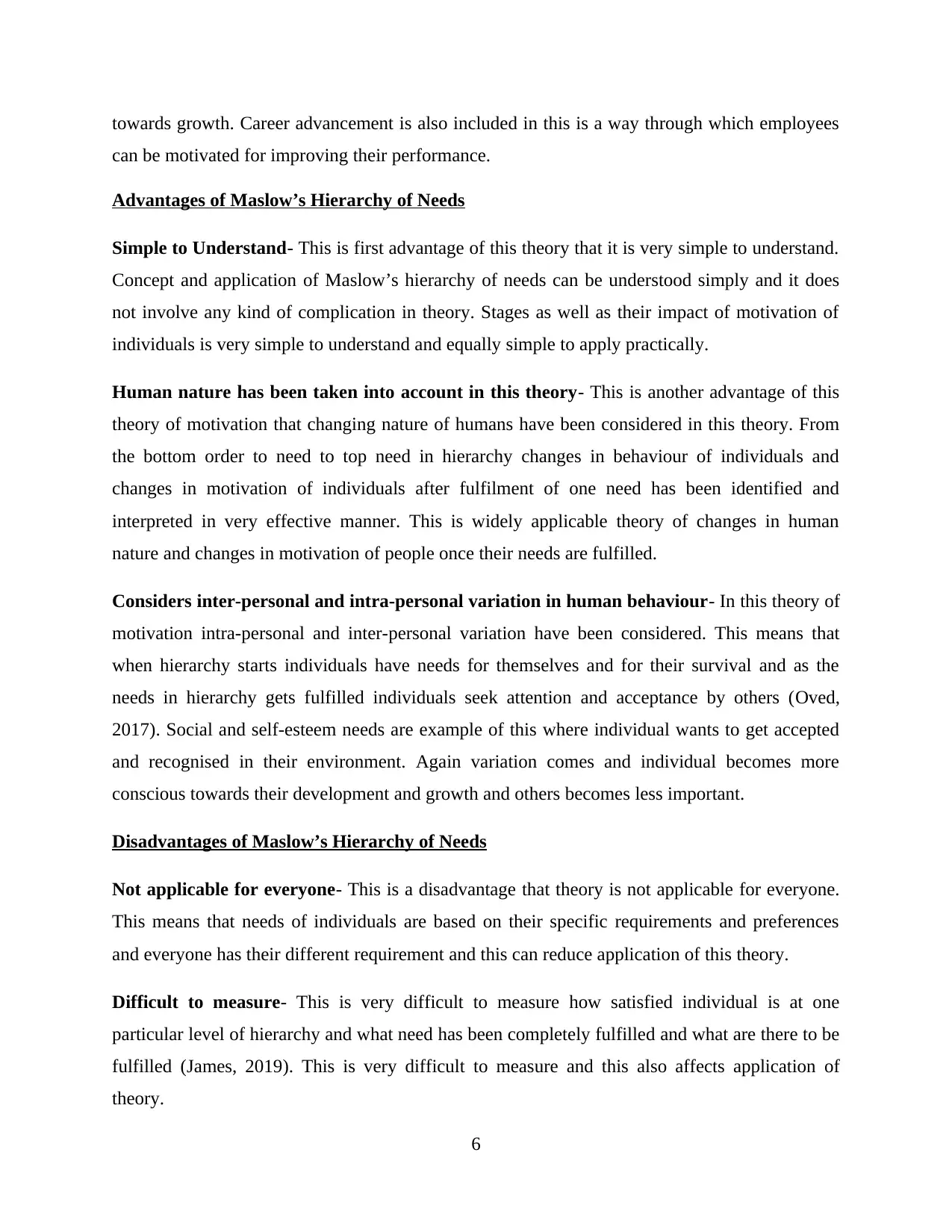
towards growth. Career advancement is also included in this is a way through which employees
can be motivated for improving their performance.
Advantages of Maslow’s Hierarchy of Needs
Simple to Understand- This is first advantage of this theory that it is very simple to understand.
Concept and application of Maslow’s hierarchy of needs can be understood simply and it does
not involve any kind of complication in theory. Stages as well as their impact of motivation of
individuals is very simple to understand and equally simple to apply practically.
Human nature has been taken into account in this theory- This is another advantage of this
theory of motivation that changing nature of humans have been considered in this theory. From
the bottom order to need to top need in hierarchy changes in behaviour of individuals and
changes in motivation of individuals after fulfilment of one need has been identified and
interpreted in very effective manner. This is widely applicable theory of changes in human
nature and changes in motivation of people once their needs are fulfilled.
Considers inter-personal and intra-personal variation in human behaviour- In this theory of
motivation intra-personal and inter-personal variation have been considered. This means that
when hierarchy starts individuals have needs for themselves and for their survival and as the
needs in hierarchy gets fulfilled individuals seek attention and acceptance by others (Oved,
2017). Social and self-esteem needs are example of this where individual wants to get accepted
and recognised in their environment. Again variation comes and individual becomes more
conscious towards their development and growth and others becomes less important.
Disadvantages of Maslow’s Hierarchy of Needs
Not applicable for everyone- This is a disadvantage that theory is not applicable for everyone.
This means that needs of individuals are based on their specific requirements and preferences
and everyone has their different requirement and this can reduce application of this theory.
Difficult to measure- This is very difficult to measure how satisfied individual is at one
particular level of hierarchy and what need has been completely fulfilled and what are there to be
fulfilled (James, 2019). This is very difficult to measure and this also affects application of
theory.
6
can be motivated for improving their performance.
Advantages of Maslow’s Hierarchy of Needs
Simple to Understand- This is first advantage of this theory that it is very simple to understand.
Concept and application of Maslow’s hierarchy of needs can be understood simply and it does
not involve any kind of complication in theory. Stages as well as their impact of motivation of
individuals is very simple to understand and equally simple to apply practically.
Human nature has been taken into account in this theory- This is another advantage of this
theory of motivation that changing nature of humans have been considered in this theory. From
the bottom order to need to top need in hierarchy changes in behaviour of individuals and
changes in motivation of individuals after fulfilment of one need has been identified and
interpreted in very effective manner. This is widely applicable theory of changes in human
nature and changes in motivation of people once their needs are fulfilled.
Considers inter-personal and intra-personal variation in human behaviour- In this theory of
motivation intra-personal and inter-personal variation have been considered. This means that
when hierarchy starts individuals have needs for themselves and for their survival and as the
needs in hierarchy gets fulfilled individuals seek attention and acceptance by others (Oved,
2017). Social and self-esteem needs are example of this where individual wants to get accepted
and recognised in their environment. Again variation comes and individual becomes more
conscious towards their development and growth and others becomes less important.
Disadvantages of Maslow’s Hierarchy of Needs
Not applicable for everyone- This is a disadvantage that theory is not applicable for everyone.
This means that needs of individuals are based on their specific requirements and preferences
and everyone has their different requirement and this can reduce application of this theory.
Difficult to measure- This is very difficult to measure how satisfied individual is at one
particular level of hierarchy and what need has been completely fulfilled and what are there to be
fulfilled (James, 2019). This is very difficult to measure and this also affects application of
theory.
6
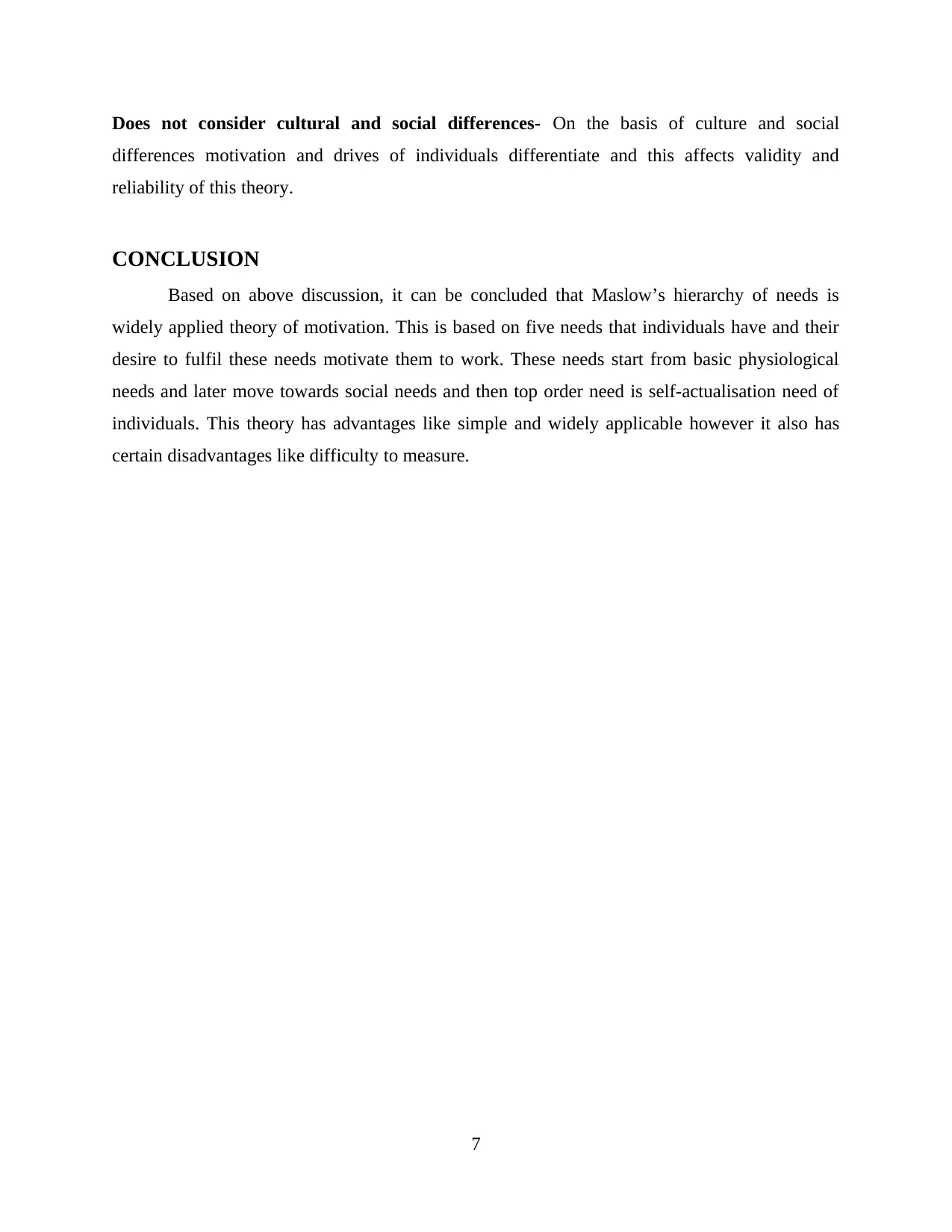
Does not consider cultural and social differences- On the basis of culture and social
differences motivation and drives of individuals differentiate and this affects validity and
reliability of this theory.
CONCLUSION
Based on above discussion, it can be concluded that Maslow’s hierarchy of needs is
widely applied theory of motivation. This is based on five needs that individuals have and their
desire to fulfil these needs motivate them to work. These needs start from basic physiological
needs and later move towards social needs and then top order need is self-actualisation need of
individuals. This theory has advantages like simple and widely applicable however it also has
certain disadvantages like difficulty to measure.
7
differences motivation and drives of individuals differentiate and this affects validity and
reliability of this theory.
CONCLUSION
Based on above discussion, it can be concluded that Maslow’s hierarchy of needs is
widely applied theory of motivation. This is based on five needs that individuals have and their
desire to fulfil these needs motivate them to work. These needs start from basic physiological
needs and later move towards social needs and then top order need is self-actualisation need of
individuals. This theory has advantages like simple and widely applicable however it also has
certain disadvantages like difficulty to measure.
7
Paraphrase This Document
Need a fresh take? Get an instant paraphrase of this document with our AI Paraphraser
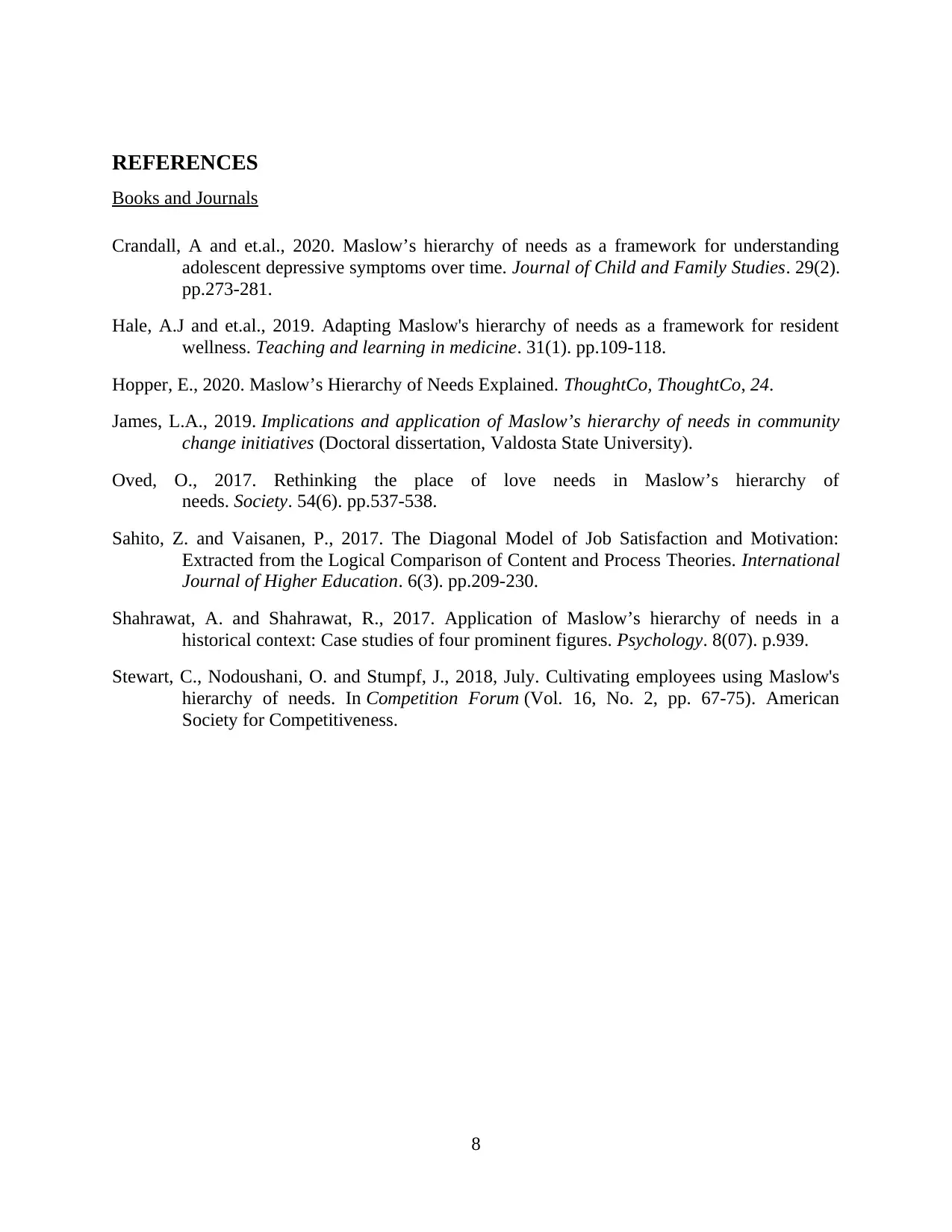
REFERENCES
Books and Journals
Crandall, A and et.al., 2020. Maslow’s hierarchy of needs as a framework for understanding
adolescent depressive symptoms over time. Journal of Child and Family Studies. 29(2).
pp.273-281.
Hale, A.J and et.al., 2019. Adapting Maslow's hierarchy of needs as a framework for resident
wellness. Teaching and learning in medicine. 31(1). pp.109-118.
Hopper, E., 2020. Maslow’s Hierarchy of Needs Explained. ThoughtCo, ThoughtCo, 24.
James, L.A., 2019. Implications and application of Maslow’s hierarchy of needs in community
change initiatives (Doctoral dissertation, Valdosta State University).
Oved, O., 2017. Rethinking the place of love needs in Maslow’s hierarchy of
needs. Society. 54(6). pp.537-538.
Sahito, Z. and Vaisanen, P., 2017. The Diagonal Model of Job Satisfaction and Motivation:
Extracted from the Logical Comparison of Content and Process Theories. International
Journal of Higher Education. 6(3). pp.209-230.
Shahrawat, A. and Shahrawat, R., 2017. Application of Maslow’s hierarchy of needs in a
historical context: Case studies of four prominent figures. Psychology. 8(07). p.939.
Stewart, C., Nodoushani, O. and Stumpf, J., 2018, July. Cultivating employees using Maslow's
hierarchy of needs. In Competition Forum (Vol. 16, No. 2, pp. 67-75). American
Society for Competitiveness.
8
Books and Journals
Crandall, A and et.al., 2020. Maslow’s hierarchy of needs as a framework for understanding
adolescent depressive symptoms over time. Journal of Child and Family Studies. 29(2).
pp.273-281.
Hale, A.J and et.al., 2019. Adapting Maslow's hierarchy of needs as a framework for resident
wellness. Teaching and learning in medicine. 31(1). pp.109-118.
Hopper, E., 2020. Maslow’s Hierarchy of Needs Explained. ThoughtCo, ThoughtCo, 24.
James, L.A., 2019. Implications and application of Maslow’s hierarchy of needs in community
change initiatives (Doctoral dissertation, Valdosta State University).
Oved, O., 2017. Rethinking the place of love needs in Maslow’s hierarchy of
needs. Society. 54(6). pp.537-538.
Sahito, Z. and Vaisanen, P., 2017. The Diagonal Model of Job Satisfaction and Motivation:
Extracted from the Logical Comparison of Content and Process Theories. International
Journal of Higher Education. 6(3). pp.209-230.
Shahrawat, A. and Shahrawat, R., 2017. Application of Maslow’s hierarchy of needs in a
historical context: Case studies of four prominent figures. Psychology. 8(07). p.939.
Stewart, C., Nodoushani, O. and Stumpf, J., 2018, July. Cultivating employees using Maslow's
hierarchy of needs. In Competition Forum (Vol. 16, No. 2, pp. 67-75). American
Society for Competitiveness.
8
1 out of 8
Related Documents
Your All-in-One AI-Powered Toolkit for Academic Success.
+13062052269
info@desklib.com
Available 24*7 on WhatsApp / Email
![[object Object]](/_next/static/media/star-bottom.7253800d.svg)
Unlock your academic potential
© 2024 | Zucol Services PVT LTD | All rights reserved.





